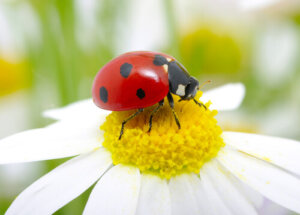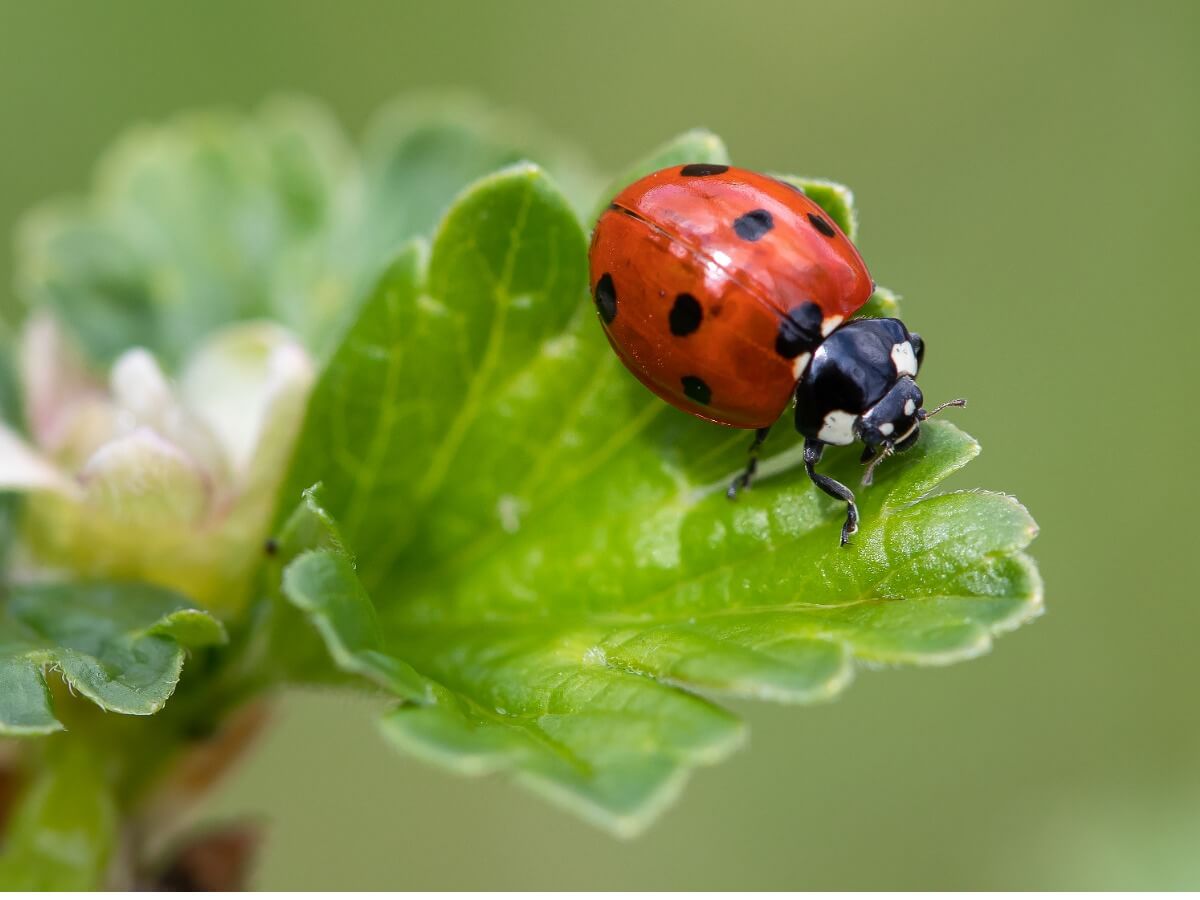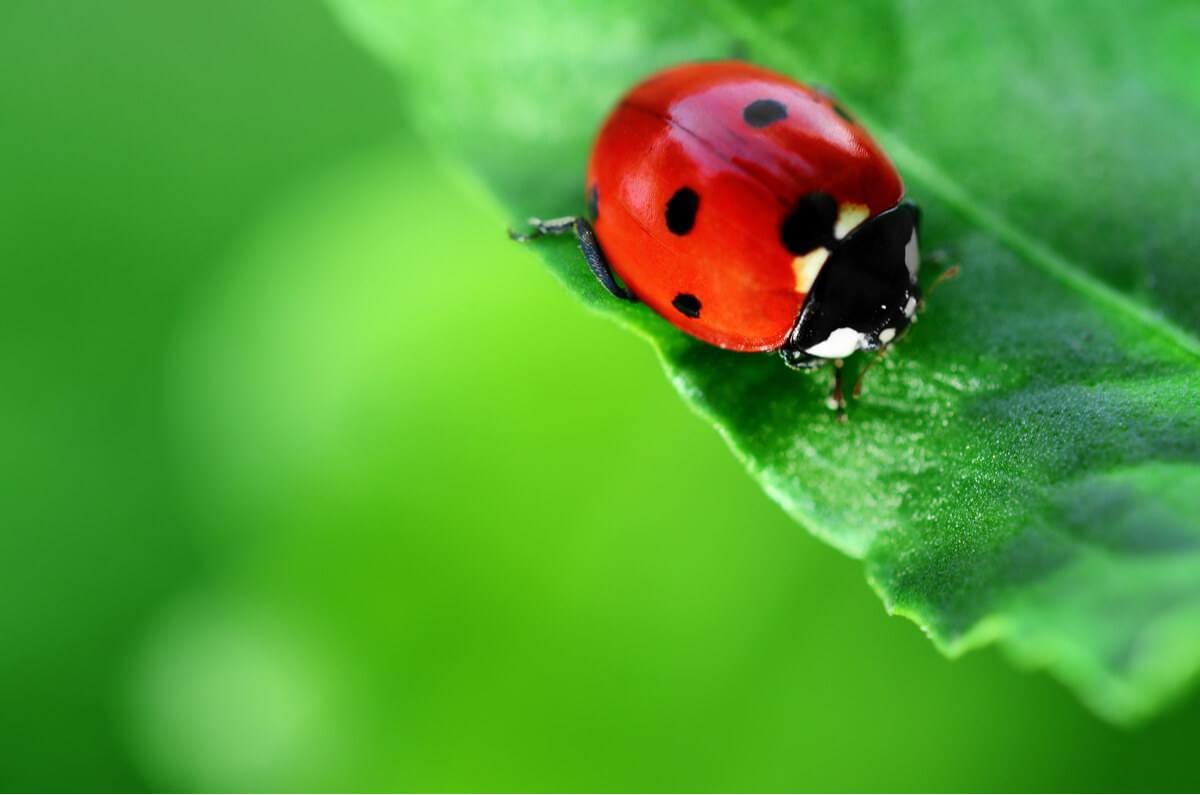Have You Heard of the Seven-Spotted Ladybug?


Written and verified by the biologist Cesar Paul Gonzalez Gonzalez
The seven-spotted ladybug is the most common and popular ladybug species in Europe and parts of the Americas. However, due to its usefulness as a pest controller, it has been introduced to other places such as the Middle East and Africa.
The scientific name of this species is Coccinella septempunctata. It belongs to the family Coccinelliddae, which groups together the Coleoptera colloquially known as ladybugs. Read on to find out more about the seven-spotted ladybug.
Habitat and distribution
This species is native to Europe and Asia, but can now be found in other places such as North America, India, Africa, and the Middle East. It’s usually restricted to living in heavily vegetated areas such as shrubs, grasses, trees, and even swamps.
Because its habitats are very unspecific, it’s common to find the seven-spotted ladybug in crop fields, gardens and urban parks. This is one of the reasons why the population recognizes this particular species well.

Physical characteristics of the seven-spotted ladybug
Like other coleopterans, the seven-spotted ladybug has a small, oval shape. It averages between 7 and 12 millimeters (0.3 to 0.5 inches) in length, so it can be quite difficult to see with the naked eye. It has two pairs of wings: flexible and folding wings that allow it to fly and other hardened wings that serve as protection for the former (elytra).
The body of this coleopteran is divided into 3 distinct areas: the head, thorax, and abdomen. The head contains the eyes, antennae, and mouth, while the thorax includes the limbs and the two pairs of wings. For its part, the abdomen usually holds the ladybug’s organs, so it’s usually wider and more oval than the rest of the body.
In terms of coloration, the ladybug’s body is black, with some white spots scattered in different body regions. However, the hardened wings (elytra) exhibit a bright red color with 7 black spots on their surface. Because this region is the most striking and typical part of the species, it was decided to name it the “seven-spotted ladybug”, although it can actually have up to 9 spots in total.
These invertebrates go through several stages during their life: larva, pupa and adult. The larvae have a worm-like shape with colors that vary according to the temperature, but are mostly dark or opaque. As for the pupa, this is an intermediate stage in which the larva hardens its exoskeleton and metamorphosis occurs, allowing it to transform into an adult.
Behavior
The seven-spotted ladybug is a diurnal animal that’s active most of the day. They usually use their time to forage alone, although they may also form groups to survive during the winter season.
Seven-spotted ladybug feeding
While the seven-spotted ladybug is known to be a predator of aphids, they actually consume a wide variety of food. In general, they’re capable of preying on small insects, pollen, or even committing cannibalism. It all depends on the availability of resources and the presence of their prey.
The ladybug as a pest controller
Despite its size, the seven-spotted ladybug is a voracious invertebrate capable of killing aphids and whitefly larvae in a short time. Because of this, it has been considered a viable species for use as a biological controller. In fact, some studies mention that each individual could consume a little more than 500 aphids or larvae in its lifetime (1 or 2 years).
Thanks to its voracious appetite, a seven-spotted ladybug population could reduce or completely eliminate several insect pests in as little as 30 days. Of course, such a scenario will depend greatly on the extent of the crop, the number of ladybugs, and the severity of the infestation.
Reproduction
The seven-spotted ladybug is a polygamous species that reproduces with many different mates each mating season. This process takes place in the summer and spring, although some populations may even extend into the fall.
Mating is simple, with males approaching females and “courting” them by gently rubbing their antennae together. If all goes well and the female accepts the advances, the male mounts and fertilizes her. On average, each ladybug repeats this same process 4 to 6 times a day with different mates. This ensures the fertilization of the eggs and increases the reproduction rate of the species.
Generally, the female lays about 15 eggs per season and between 200 and 500 in her lifetime. In fact, to avoid a fight for resources, most females tend to select areas where there are no eggs laid by their fellow ladybugs. This maximizes the survival rate and reduces the probability of cannibalism.

As you can see, the seven-spotted ladybug is quite an interesting species that has been in the spotlight of scientists and the general population. This is because it isn’t only an invertebrate of great beauty, but it can also be used as a biological controller of aphids that affect crops. Despite being small, it’s still valuable to people and the ecosystem.
The seven-spotted ladybug is the most common and popular ladybug species in Europe and parts of the Americas. However, due to its usefulness as a pest controller, it has been introduced to other places such as the Middle East and Africa.
The scientific name of this species is Coccinella septempunctata. It belongs to the family Coccinelliddae, which groups together the Coleoptera colloquially known as ladybugs. Read on to find out more about the seven-spotted ladybug.
Habitat and distribution
This species is native to Europe and Asia, but can now be found in other places such as North America, India, Africa, and the Middle East. It’s usually restricted to living in heavily vegetated areas such as shrubs, grasses, trees, and even swamps.
Because its habitats are very unspecific, it’s common to find the seven-spotted ladybug in crop fields, gardens and urban parks. This is one of the reasons why the population recognizes this particular species well.

Physical characteristics of the seven-spotted ladybug
Like other coleopterans, the seven-spotted ladybug has a small, oval shape. It averages between 7 and 12 millimeters (0.3 to 0.5 inches) in length, so it can be quite difficult to see with the naked eye. It has two pairs of wings: flexible and folding wings that allow it to fly and other hardened wings that serve as protection for the former (elytra).
The body of this coleopteran is divided into 3 distinct areas: the head, thorax, and abdomen. The head contains the eyes, antennae, and mouth, while the thorax includes the limbs and the two pairs of wings. For its part, the abdomen usually holds the ladybug’s organs, so it’s usually wider and more oval than the rest of the body.
In terms of coloration, the ladybug’s body is black, with some white spots scattered in different body regions. However, the hardened wings (elytra) exhibit a bright red color with 7 black spots on their surface. Because this region is the most striking and typical part of the species, it was decided to name it the “seven-spotted ladybug”, although it can actually have up to 9 spots in total.
These invertebrates go through several stages during their life: larva, pupa and adult. The larvae have a worm-like shape with colors that vary according to the temperature, but are mostly dark or opaque. As for the pupa, this is an intermediate stage in which the larva hardens its exoskeleton and metamorphosis occurs, allowing it to transform into an adult.
Behavior
The seven-spotted ladybug is a diurnal animal that’s active most of the day. They usually use their time to forage alone, although they may also form groups to survive during the winter season.
Seven-spotted ladybug feeding
While the seven-spotted ladybug is known to be a predator of aphids, they actually consume a wide variety of food. In general, they’re capable of preying on small insects, pollen, or even committing cannibalism. It all depends on the availability of resources and the presence of their prey.
The ladybug as a pest controller
Despite its size, the seven-spotted ladybug is a voracious invertebrate capable of killing aphids and whitefly larvae in a short time. Because of this, it has been considered a viable species for use as a biological controller. In fact, some studies mention that each individual could consume a little more than 500 aphids or larvae in its lifetime (1 or 2 years).
Thanks to its voracious appetite, a seven-spotted ladybug population could reduce or completely eliminate several insect pests in as little as 30 days. Of course, such a scenario will depend greatly on the extent of the crop, the number of ladybugs, and the severity of the infestation.
Reproduction
The seven-spotted ladybug is a polygamous species that reproduces with many different mates each mating season. This process takes place in the summer and spring, although some populations may even extend into the fall.
Mating is simple, with males approaching females and “courting” them by gently rubbing their antennae together. If all goes well and the female accepts the advances, the male mounts and fertilizes her. On average, each ladybug repeats this same process 4 to 6 times a day with different mates. This ensures the fertilization of the eggs and increases the reproduction rate of the species.
Generally, the female lays about 15 eggs per season and between 200 and 500 in her lifetime. In fact, to avoid a fight for resources, most females tend to select areas where there are no eggs laid by their fellow ladybugs. This maximizes the survival rate and reduces the probability of cannibalism.

As you can see, the seven-spotted ladybug is quite an interesting species that has been in the spotlight of scientists and the general population. This is because it isn’t only an invertebrate of great beauty, but it can also be used as a biological controller of aphids that affect crops. Despite being small, it’s still valuable to people and the ecosystem.
All cited sources were thoroughly reviewed by our team to ensure their quality, reliability, currency, and validity. The bibliography of this article was considered reliable and of academic or scientific accuracy.
- Angalet, G. W., Tropp, J. M., & Eggert, A. N. (1979). Coccinella septempunctata in the United States: recolonizations and notes on its ecology. Environmental Entomology, 8(5), 896-901.
- Marples, N. M., van Veelen, W., & Brakefield, P. M. (1994). The relative importance of colour, taste and smell in the protection of an aposematic insect Coccinella septempunctata. Animal Behaviour, 48(4), 967-974.
- TRILTSCH, H. (1999). Food remains in the guts of Coccinella septempunctata (Coleoptera: Coccinellidae) adults and larvae. European Journal of Entomology, 96(4), 355-364.
- Hodek, I., & Michaud, J. P. (2013). Why is Coccinella septempunctata so successful?(A point-of-view). EJE, 105(1), 1-12.
- SRIVASTAVA, S. (2013). The reproductive behaviour of an aphidophagous ladybeetle, Coccinella septempunctata (Coleoptera: Coccinellidae). EJE, 99(4), 465-470.
- Bauer, T. (2013). “Coccinella septempunctata” (On-line), Animal Diversity Web. Recuperado el 30 de noviembre de 2022, disponible en: https://animaldiversity.org/accounts/Coccinella_septempunctata/
This text is provided for informational purposes only and does not replace consultation with a professional. If in doubt, consult your specialist.








